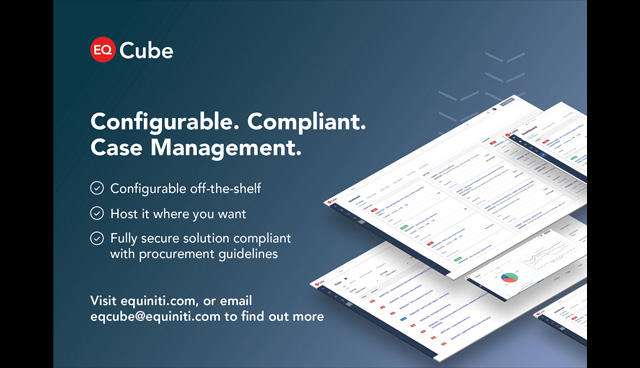Innovative case management in a compliant world

In the last decade-and-a-half, advances in case management systems have created significant digital opportunities across the public service. Andrew Hughes, Technical Pre-Sales Lead with Equiniti (EQ) ICS, writes.
The development of case management systems over the past 15 years has presented public sector organisations with opportunities to digitise long-lived collaborative processes, centralising all aspects of a case through content, communication, and resource, helping reach pre-defined objectives.
Crucially, the rise of online services means such systems are now easily within reach of citizens, regardless of location, increasing accessibility and developing processes around the needs of users.
In the early days of digital government, systems were developed for individual organisational requirements. This was expensive to build, expensive to buy, and led to long procurement cycles and lead times.
Organisations did ultimately benefit from fully bespoke systems built around their needs, which admittedly does sound good, cost withstanding. The practicalities when it came to renewing contracts or changing suppliers rendered this process unsustainable in the long run though. Neither did it comply with the Government’s long standing digital objective of delivering single user identities and a ‘joined up’ single citizen view across departments.
The goal of digital government is clear; to build a simple, joined-up and personalised experience for everyone. The emphasis being on digitising high-volume transactional services, and developing technology platforms to cope, centred on accessibility and user needs.
As such, established guidance and compliance measures for buyers and suppliers is provided, working towards maintaining software standards in line with digital government aspirations.
Public sector case management providers seeking to strike partnerships with public bodies must ensure their solutions are compliant, whilst still meeting the underlying business requirements of individual organisations and departments, as well as introducing digital innovation that genuinely improves process and service.
Case management in a compliant world
Complying with digital government guidelines means solutions need to cater for cloud-based storage, accessibility, and provide a degree of flexibility for organisations to modify a system for their requirements, off-the-shelf.
Can a case management system tick these compliance boxes yet still deliver solutions that cater for an organisation’s unique requirements?
There is an interesting paradox when it comes to answering this question. The rising demand for off-the-shelf solutions, moving hand-in-hand with the rise of SaaS and cloud-based platforms.
Given the degree of governance that public bodies are subject to, there is a real balancing act for suppliers to help meet the demand for off-the-shelf solutions, whilst meeting the underlying business requirements of individual business units.
For organisations which understand user requirements, there is a clear opportunity to ‘productise’ solution offerings. Providing commercial off-the-shelf (COTS) products which heed digital government compliance and provide organisations with quickly deployed and accessible solutions as a service.
“EQ has never been an organisation that said, ‘our product does not do that’. Instead, it has prided itself in its ability to engage and provide solutions to customers over many years that address their complex requirements.”
Whilst this sounds like the ideal fit for the current digital landscape, we cannot help but ask, ‘is the tail wagging the dog?’. Has there been a move to cloud-based case management, that compliance has overtaken the fundamental business requirements of the customer? Are organisations and departments able to procure solutions which meets their business requirements, or are they changing their business to meet product limitations?
We regularly observe organisations and departments who ‘solution hop’. Instead of longer relationship driven solutions with suppliers, products or cloud services are procured for periods of between two and three years, before jumping to the next ‘thing’. Have we moved away from those bespoke solutions to such an extent, that the compliant products, struggle to cover the fundamental business requirements?
EQ and configurable, compliant, case management
EQ’s experience in working closely with public sector organisations has enabled it to develop a comprehensive understanding of user requirements. This knowledge and experience led it to take a blank piece of paper and directly address the challenges faced by public sector departments and organisations. EQ is a long-standing expert in the provision of complex case management solutions for the public sector, focused on customer requirements.
EQ has never been an organisation that said, ‘our product does not do that’. Instead, it has prided itself in its ability to engage and provide solutions to customers over many years that address their complex requirements. This is borne out by its customer base, providing core line of business solutions to areas of the public sector with high levels of legislative compliance such as insolvency, health and safety and police complaints.
With this experience and this background as its starting point, EQ set out to build a completely new solution. One that would enable public sector departments and organisations to meet the demands of digital government, whilst still providing them with the configurable flexibility required to meet their business requirements. From this exercise, EQ Cube was born.
At its heart, EQ Cube sought to address three fundamental concepts:
Configurable: EQ wanted customers to be able to take the product and make it what they wanted. It wanted to put more power in the hands of the customer, allowing them to meet their own business requirements, without having to rely on suppliers. EQ Cube can be provided as turnkey. The customer can configure it to their requirements without the need for additional services if required.
Compliant: EQ wanted customers to be assured that their solution provides the levels of data security, accessibility and all-around compliance stated within digital Government guidelines. EQ Cube is designed against WCAG 2.1 accessibility standards, whilst being capable of being deployed and managed as a service on Secure Private Cloud (EQ Cloud), Public Cloud (Microsoft Azure) or on-prem in customer data centres.
Case Management: EQ wanted to ensure its experience was brought to the fore and that it did not forget the fundamentals of being an innovative and intuitive case management solution. EQ Cube is built around Case and Party entities with multi-layered user access, out of the box data reporting and dashboards, and customer focused timelines.
Finally, EQ wanted to ensure that it continued to do what it has done best; that it does not say ‘no’ to a customer and that it provides a solution that meets all their business requirements. For that reason, EQ Cube is built using modules. Small parcels of independent capability and functionality which can be configured, changed, or constructed.
- Configure: Take the product on day one and configure your users, fields, and processes as you require.
- Change: Swap out a module for a version that meets your exact requirements.
- Construct: Add to the solution. Complex requirements met with EQ constructed additional modules.
This is the EQ Method. Not treating digital compliance as a roadblock, but as a driver for innovative change and improvement.
For more information, please contact:
E: Andrew.Hughes@equiniti.com
W: www.equiniti.com






